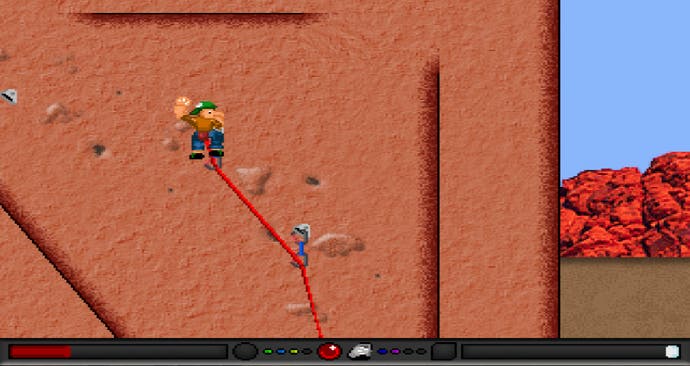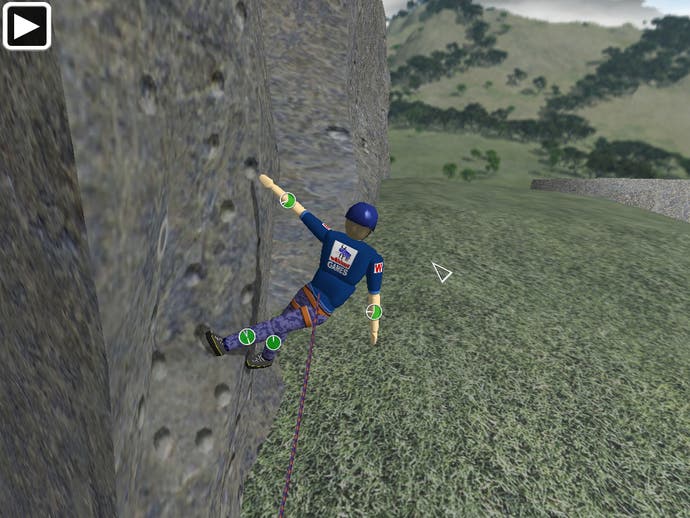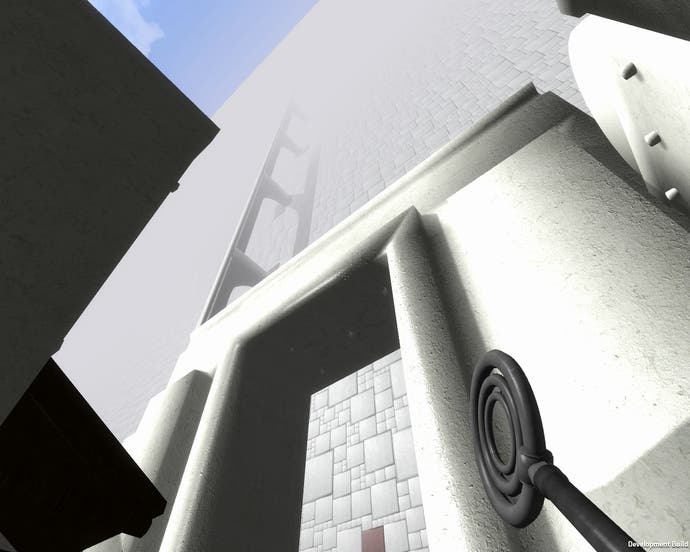Belayed potential: The art of videogame climbing
Getting to the crux of why there are so few climbing games, and how that could change in the near future.
I manage to reach halfway up the corner of the church before I get stuck. I can see where I need to go, but there are no firm handholds within reach. No, I'm not playing Assassin's Creed, though I half-wish I was. The church wall I'm clinging to like a fat spider overlooks Newhaven Harbour at the north end of Edinburgh. The old Gothic building houses the Alien Rock indoor climbing centre, its interior walls and vaulted ceilings covered in white plaster and fluorescent plastic climbing holds.
I thought I would be terrified if this happened. I'm not afraid of heights, but I can't handle unstable footing. Instead I'm just tired and frustrated. It started well enough - I climbed two starter routes without much trouble - but this is my third attempt on this route. My fiancée ascended it earlier with no problems, and a ten-year-old girl has just scurried up the wall beside me like a squirrel.
This somewhat rash transition from sedentary games journalist to human wallpaper is the final part of an investigation into the portrayal of climbing in games. I decided to try it for myself because of something said to me by Dana Harrington, an experienced climber and creator of the climbing game Solo Joe.
"Climbers don't tend to be gamers and gamers, I don't want to say they're callous, but I don't think they care about the same things climbers care about."
Struggling on that wall with children sailing past me, I had a feeling he was right. Certainly, gaming's relationship with climbing is a strange one. Climbing has been a part of the medium since the early 1980s, when platformers like Donkey Kong were restricted to a single, static screen, and needed to make the most of that space.

It's an obvious premise for a game. There's a clear objective - get to the top - and the inherent peril of falling. Challenges naturally emerge from puzzling out the best routes, and there are many different types of tools that can be used in the ascent, from Donkey Kong's ladders to Modern Warfare 2's ice-axes, all of which appeal to the gaming mindset.
But the moment scrolling graphics arrived gaming reached a crossroads and decided that going right was preferable to going upward. Since then very few games have focussed upon climbing. Some recent examples, such as Assassin's Creed, Skyrim and Dark Souls, have used verticality in impressive ways, but the climbing involved remains rudimentary, a case of jumping over obstacles, using a ladder, or holding up to ascend a wall.
However, there are a handful of games, all developed entirely by individuals, which are exploring how to implement climbing in more meaningful ways, both mechanically and as a game concept. When considered together, they may just herald a bright future for climbing games.
Harrington's Solo Joe is one such example. A climber for around a decade, Harrington specialises in bouldering: short, technically challenging climbs done without ropes. He built Solo Joe between 2003 and 2011, out of a desire to able to scratch his climbing itch on a rainy day, something which other games he had seen had failed to do.
"The one thing I can say is any climbing I have seen in other games doesn't inspire the climber in me," explains Harrington. "Your body moves in a certain way, and the rock has certain features, and it's learning the choreography, learning how you can move your body, how you can hold under the rock. That sort of choreography just doesn't exist in the examples in other games."
Solo Joe was limited by Harrington learning to code as he made it, so it doesn't attempt realistic visuals. Instead, it focuses on the problem-solving and resource management element of climbing; "protecting a route" by clipping the rope to the rock in the right places, ensuring your hands are sufficiently chalked to grip the holds, navigating "cruxes", particularly difficult sections of rock represented by various types of mini-games. "In other games, it's not about protecting a route, or problem solving, it's about movement, and I'm not inspired by that movement."
Harrington is adamant that Solo Joe is a game for climbers rather than gamers, and this comes across in its design. It comes with a 42-page manual that is required reading to navigate even the first wall, and has idiosyncrasies that are infuriating for a gamer. Z and X are the primary control buttons, and pressing Escape immediately quits the game. But as a climbing simulator it is vastly superior to any mainstream title. Each route is complex and involved, falling is a real danger, and most importantly it is about the journey rather than the destination.

Solo Joe is a great template for climbing games. But it doesn't herald the future for them, as it doesn't take advantage of the technology games now have available to them. A more promising game in this regard is Vertigo, a physics-based climbing simulator created by Wildebeest games. Here, the player manipulates the individual limbs of a climber in order to scale a wall. Instead of animations, vertigo uses a powered-physics system to represent the skeleton and musculature of a human being.
"With the powered ragdoll system you can have a library of pre-defined stances that you want to move between," says Mark Judd, the creator of Vertigo. "If you change your mind about which target stance you want the ragdoll to be aiming for midway through a movement, there's no jump or stutter, the limbs smoothly head for the new target positions from wherever they happened to be."
Like Harrington, Judd used personal experience to shape his game, but as a programmer who learned to climb rather than a climber who learned to program. "I actually wound up building a climbing wall in my back garden. It became apparent really quickly that I suck at climbing. It surprised me how much stamina you need in order to make any real progress."
This was translated into Vertigo. Placement of limbs affects the amount of stress on them, so each move must be thought through carefully else the climber will quickly tire and fall off the wall. To combat this, the player can rest individual limbs by letting them hang free of the wall. "This cycle of tiring a limb to the point of it becoming weak and then resting it also has an effect on the limb's stamina, so the more you work it, the quicker it will become tired."
Alongside a fairly realistic simulation of limb movement and stamina, Judd's powered physics system also enables certain specific climbing manoeuvres to be replicated. For instance, manteling, whereby the climber pushes themselves up the rock using their arms, can be performed. It doesn't cater for all climbing techniques, as some manipulation of different forces that are yet to be programmed. "The game doesn't mimic friction holds at the moment," Judd points out. "So laybacking, where you can climb a vertical edge by gripping the sides of the edge using friction with your feet in a sort of pinch movement, will not work."
Though it is still very much in alpha, Vertigo demonstrates a deft understanding of the relationship in climbing between the climber and the rock, and the technology it uses should be of considerable interest to anyone looking to further virtual climbing. But while both Vertigo and Solo Joe portray climbing in a very satisfying way, their representation of it as a pure sports challenge is likely to have limited appeal. If a climbing game is to go beyond the niche of climbing enthusiasts and curious gamers, it needs to have a sense of adventure.
Michael Consoli's Against The Wall approaches the concept of a climbing game from a completely different angle. It makes no attempt to represent climbing movement or challenges in a realistic way. Indeed, the only climbing gear the character has access to is a magic wand. It challenges the player with ascending an enormous, sheer wall by using the wand to pull out the wall's bricks and clamber atop them.
Whereas Solo Joe and Vertigo focus on small, tricky climbs and managing their effect on the human body, Against the Wall is all about the scale of the obstacle, and the adventure and exploration that occurs along the way. "Gravity it an obstacle in itself. It's just a natural thing to overcome," says Consoli. "There's something about being high up, and getting high up that is its own reward. Having a scenic view, being able to look down on your progress on how you've climbed and what you have climbed, and feeling pride in that."
Unlike Solo Joe and Vertigo, and indeed most climbing games, Against the Wall is first person, which elsewhere has made climbing problematic. Consoli refers to Mirror's Edge as an example of the difficulties inherent in first person climbing. "Your face is right against the textures in Mirror's Edge. Here that's optional. You can jump from afar to get from place to place. You don't have to stick your face right into something and then pull yourself up."

The first person-perspective also gives the player a much clearer sense of the scale of the wall. Individual bricks can be three or four times the height of the player, and peering over the edge into the abyss below can be a stomach twisting experience. "I have friends who can't play my game, because of that," says Consoli "I have no idea why. Maybe it's the height, maybe it's the field of view - I have an option in the newer version to turn it off or adjust it as you want."
Perhaps the most interesting feature of Against The Wall, however, is how it plans to merge the challenge of climbing with a narrative that provides a reason for climbing the wall. The wall's blocks have different properties; some will start to retract when stepped on while others will bounce the player into the air, meaning the player has to adjust their climbing strategy as the nature of the wall changes.
At the same time, cities and horizontal forests procedurally appear on the wall, combined with set pieces that, according to Consoli, will link events together. "The narrative is not one that I express verbally. Events will happen as you go up the wall. There will be set pieces, and things that you will encounter that will progress what is happening."
Against the Wall is definitely the most promising climbing game on the horizon, combining the challenge of climbing with the grandeur of gaming. But I believe there's still a lot of untapped potential in this area. I want to see the mechanics of climbing explored in these games merged with the scope and narratives the biggest games can offer. Imagine if Skyrim had you clambering the cliffs and crags of its towering mountain ranges, rather than trudging up well-worn paths around them. Imagine if Dark Souls gave you more than rickety ladders and precarious walkways to explore its incredible vertical world with. Imagine if Modern Warfare 2 had built an entire game around its all too brief ice-climbing section.
I failed my third attempt to scale the church wall, too tired and sore to continue. My climbing instructor, a gentle voiced former soldier named Andy, smiled as I stared up at the route which had beaten me. "I've seen that look before," he said. Truth be told, I'd felt that way before, and I realised that Dana had been wrong. Climbers and gamers care about exactly the same things, we just chase them in different ways. Perhaps that's why the two have rarely crossed paths in all this time, and why we're only just beginning to see it happen.

